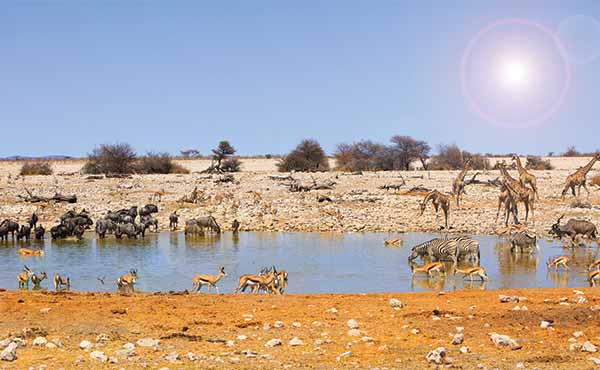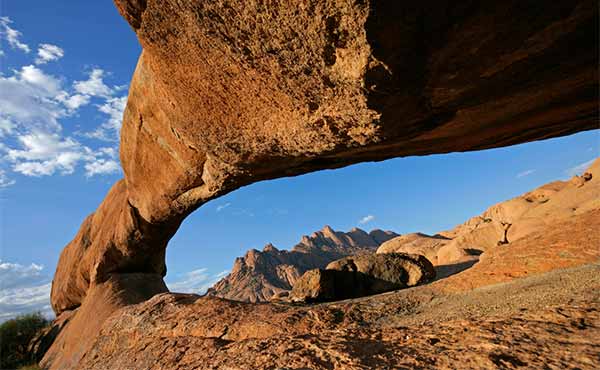Etosha National Park

Home to some of the most diverse landscapes in Namibia, Etosha National Park is a haven for a myriad of wildlife and offers some of the finest encounters in Southern Africa. Find out more about Etosha National Park
A community project is a fantastic opportunity for your pupils to engage with another culture and make a contribution to a local school. After the project, you can take in some of the natural sights of Namibia and round off the trip with a big game safari at Etosha.
Arrive in Namibia mid-morning at Windhoek, the capital of the country. You will be met by your driver/guide who will accompany you for your entire expedition. You will be taken to your accommodation and the afternoon will be spent purchasing the materials required for your project. You will be taken to a hardware store where all equipment and materials can be collected. In the evening you will have a meal in town.
This morning you will need to travel to your project School, arriving by lunch time to make your introductions. Once you have unloaded your truck you will need to make preparations to start your project work tomorrow.
Your project may involve a whole host of tasks, but primarily it is likely that you will be asked to upgrade the recreational facilities of the school by building a climbing frame and swings.
In addition, the educational environment of the school will need attention, so you should expect to-replaster and re-paint walls, and certainly follow the schools desire to have education murals placed around the schools to be used for teaching.
It will be essential that you are able to look at the bigger picture during your stay at the school and identify other ways in which you can help. You may decide to help create a vegetable garden or a chicken coop. Rural schools in the south of Namibia are slowly becoming more self sufficient, but you may discover that your hosts are yet to grown their own food.
Other activities you may wish to design are football, netball or basketball matches after school hours. These competitions are a great way to interact and have fun with the local students. Alternatively you may wish to have a cultural exchange whereby you explain to the students about your life at home and at school. This can often be a very rewarding exchange.
Finally, you may wish to get involved with the teaching at the school buy assisting in one of the classrooms. It is unlikely that you will be able to lead a class completely on your own, but perhaps a simple geography lesson about the UK, your town or your home would be possible to arrange with the permission of the principal.
Today you will travel into the ancient Namib Desert. The area around Sesriem provides unforgettable sights and we recommend that you take a walk through the Sesriem Canyon late this afternoon, before heading to Dune 45 to watch the sun set over the desert.
Leaving the Namib Desert, you will travel up the coast to Swakopmund, an old colonial coastal town where you will be able to relax and enjoy the ‘luxury’ of a hotel bed and choose a restaurant venue for your evening meal.
Leaving Swakopmund, you will begin the journey north to the ancient rock formations of the Pondok Mountains and Spitzkoppe, otherwise known as the Matterhorn of Africa. Rising 1800m into the sky, the Spitzkoppe is by no means Namibia’s highest mountain, however, due to its striking outlines, it is regarded as the most well-known mountain in the country. Situated in an endless, dry plain, the island of mountains can be seen from far away and provides one of the most awesome and picturesque camping locations you can experience in the entire country.
The granite massif, which is part of the Erongo Mountains, was created by the collapse of a gigantic volcano more than 100 million years ago and the subsequent erosion, which exposed the volcanic rock, granite. One can go for beautiful walks in this stunning landscape and climb about between the bizarre rock formations. San (Bushman) paintings can be found in various places, many in the ‘Bushman Paradise’ under an overhanging rock wall, which you will have the opportunity to walk to today on circular trek of about 12kms.
Leaving Spitzkoppe you will travel to the world famous Etosha National Park. You will be camping in the main campsites tonight and you will have the opportunity to witness the wonderful wildlife of Africa from the fantastic water holes which you can view all night!
Today you will be taken on a game safari round the National Park. The best time to view the wildlife is early in the morning and in the evenings, when the heat of the sun is not so powerful and the animals are out in the open.
Having spent a couple of nights at Etosha, you will finally begin the long journey south and back to Windhoek where you will spend your final evening enjoying a celebratory meal and reflecting upon your experiences.
Today you land back in the UK. Welcome home!
 Namibia
Namibia

Home to some of the most diverse landscapes in Namibia, Etosha National Park is a haven for a myriad of wildlife and offers some of the finest encounters in Southern Africa. Find out more about Etosha National Park

Largely untouched by humans, the Namib is the oldest desert in the world, and a fabulous location to encounter the unique wildlife that has made this inhospitable environment its home. Find out more about Namib Desert

Located at the mouth of the Swakop River, Swakopmund was founded as the main harbour for the German Empire and now acts as a wonderful stop for groups exploring the length of Namibia. Find out more about Swakopmund

Rising dramatically out of the plains that surround them, the Spitzkoppe provides one of the most majestic panoramas in Namibia and a spectacular spot to explore on any itinerary to the region. Find out more about Spitzkoppe